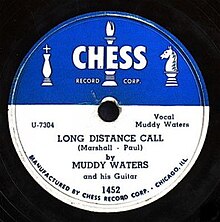На длинные дистанционные звонки (песня)

" Long Distance Call " - песня американского блюза музыканта Мадди Уотерс . Впервые он был выпущен как сингл в 1951 году Chess Records (#1452), [ 1 ] с «слишком молодым, чтобы знать» на B-стороне. Сингл достиг 8 на графике R & B США . [ 2 ] Позже он был выпущен на альбоме Greatest Hits The Best of Muddy Waters (1958) и провозглашен классической современной блюзовой песней; Пение Уотерса названо отличным примером синих нот .
Фон и содержание
[ редактировать ]«Длинный дистанционный звонок» происходит в песне «Стоны на длинные расстояния», записанная в сентябре 1929 года Blind Lemon Jefferson ( Paramount #12852). [ 1 ] В конце 1940 -х и начале 1950 -х годов Мадди Уотерс записывал тип музыки, которая помогла блюзу выжить как коммерчески жизнеспособный тип музыки. «Длинейный звонок» был записан 23 января 1951 года, когда Литтл Уолтер на гармонике и Эрнесте "Большой" Кроуфорд на басе, на сессии, которая также выпустила «слишком молодой, чтобы знать», «Honey Bee» и «Howlin 'Wolf» Полем [ 3 ] [ 4 ] [ 5 ]
В текстах представлен мужчина от первого лица, обращенный к его любовнику, просящий ее сказать ему что-то доброе. Когда наступает звонок, на большие расстояния, это только для того, чтобы сказать ему, что «еще один мул [-это] в вашем киоске». [ 6 ] Джон Коллис называет песню «медленной, медитативной и душевной стойкой», в которой есть воды (уроженец Миссисипи, затем работающий в Чикаго) «Эксплойс миграция как коммерческая тема». [3]
Reception and analysis
[edit]English trumpeter and broadcaster Humphrey Lyttelton reviewed the song (and "Hello Little Girl") in 1955 in New Musical Express, saying Waters is "a genuine contemporary blues singer".[7] In a 1969 interview, Muddy Waters himself said it was his favorite song out of all the songs he had recorded.[8] Luther "Georgia Boy" Johnson, a member of Waters's band in the 1960s, co-opted the song as his own, "complete with Muddy's gospel preaching at the song's climax".[9]
David Dicaire, in Blues Singers: Biographies of 50 Legendary Artists of the Early 20th Century, calls the song "a definitive modern blues classic".[4] David Hatch and Stephen Millward, in an analysis of blue notes, single out the song because, in their opinion, it displays Muddy Waters's mastery of blues singing, particularly his "sliding effortlessly between the major and the 'blue' tones, with just the right mixture of hope and bitterness in his voice".[10]
References
[edit]- ^ Jump up to: a b Herzhaft, Gérard (1992). Encyclopedia of the Blues (2 ed.). U of Arkansas P. p. 273. ISBN 9781610751391.
- ^ Whitburn, Joel (1988). Top R&B Singles 1942–1988. Record Research. p. 435. ISBN 0-89820-068-7.
- ^ Jump up to: a b Collis, John (1998). The Story of Chess Records. Bloomsbury. pp. 43–44. ISBN 9781582340050.
- ^ Jump up to: a b Dicaire, David (1999). Blues Singers: Biographies of 50 Legendary Artists of the Early 20th Century. McFarland. p. 81. ISBN 9780786406067.
- ^ Palmer, Robert (1989). Muddy Waters: Chess Box (Box set booklet). Muddy Waters. Chess/MCA Records. OCLC 154264537. CHD3-80002.
- ^ This last phrase is cited as an example of third-person boasting. See Melnick, Mimi Clar (1973). "'I Can Peep Through Muddy Water and Spy Dry Land': Boasts in the Blues". In Alan Dundes (ed.). Mother Wit from Laughing Barrel. UP of Mississippi. pp. 267–76. ISBN 9781617034329.
- ^ Schwartz, Roberta Freund (2013). How Britain Got the Blues: The Transmission and Reception of American Blues Style in the United Kingdom. Ashgate. pp. 56 n.26. ISBN 9781409493761.
- ^ O'Neal, Jim; van Singel, Amy (2013). The Voice of the Blues: Classic Interviews from Living Blues Magazine. Routledge. p. 201. ISBN 9781136707414.
- ^ Komara, Edward (2005). Encyclopedia of the Blues. Psychology Press. p. 534. ISBN 9780415926997.
- ^ Hatch, David; Millward, Stephen (1987). From Blues to Rock: An Analytical History of Pop Music. Manchester UP. pp. 60–61. ISBN 9780719014895.